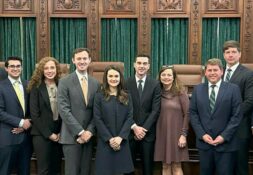The Indiana Senate passed the controversial Marriage Protection Amendment—or HJR-3—on February 17, just weeks after the amendment was diluted to make it through the House of Representatives. First passed by both chambers in 2011, the proposed constitutional amendment defined marriage as between one man and one woman, and provided “that legal status identical or substantially similar to that of marriage for unmarried individuals shall not be valid or recognized.”
This year, however, the House changed the amendment, omitting this second sentence. The state has already legislatively defined marriage as between a man and woman, and does not recognize any nonmarital relationships as legal equivalents to marriage.
Unsure if the measure would pass the House, some state Republicans bucked GOP leadership and sided with Democrats to remove the highly contentious second sentence of the amendment. This moderated version of the amendment passed the House in a 57-40 vote three weeks ago.
With the House approval, the amendment went to the Senate Rules Committee, which voted 8-4 on February 10 to send the amendment to the Senate floor. Three days later, the Senate moved to adjourn without reverting the amendment back to its initial form, thus sending the version without the second sentence to a final vote on Monday, February 17.
In order for a constitutional amendment to appear on the Indiana ballot in November, it must have been passed by both the Indiana House and Senate, in the same form, in two consecutive, separately-elected legislatures. Because the Senate passed the amendment in the House-modified form rather than the form passed in 2011, the measure cannot be included on the ballot this year.
Freedom Indiana, a coalition founded in August 2013 to defeat the amendment, believes that the content of HJR-3 would prevent Indiana from providing equality to all citizens. Campaign spokesperson Jennifer Wagner said that the coalition believes that changing the amendment in this way would be to include anti-freedom language in the state’s founding document.
“We want to send the message that Indiana is a welcoming, hospitable place,” she said in a statement to the Rover, “not a state where LGBT residents are less protected under law.”
Walter Nicgorski, Notre Dame Professor Emeritus of Program of Liberal Studies and Political Science, told the Rover that he spoke in favor of the amendment before the South Bend Common Council.
“Under our U.S. Constitution and Indiana Constitution, the judgment of the people should be the critical consideration in whether a state should see encouragement of traditional marriage in the public interest,” he stated. “Tolerance is one thing, but holding up a homosexual relationship as equivalent to a heterosexual relationship and as one having the approval of the state would not be healthy to the future of family and societal life.”
Wagner said that Freedom Indiana was pleased with the legislative decision to remove the second sentence of the amendment.
“[It] would have permanently prohibited civil unions, domestic partnerships and other legal protections,” Wagner noted, “and we remain hopeful that lawmakers will vote down the amendment entirely.”
Michael Polito, a Notre Dame graduate student studying Political Science, argued that lawmakers should reinsert the second sentence.
“Essentially identical language appears in the constitutions of a dozen and a half other states, including neighbors Michigan, Ohio, and Wisconsin,” he argued. “If the Senate does not re-insert this language, however, it should still pass the bill and deal with it again next year. We can’t let the perfect be the enemy of the good.”
Patrick Mangan, Executive Director of Citizens for Community Values of Indiana, told the Rover that the Supreme Court decision in Windsor sets strict parameters for valid exercises of state authority in defining marriage.
“If a state tries to create civil unions that are requisite to marriage but without the title, while defining marriage as between one woman and one man, this will be found unconstitutional,” Mangan explained.
“SCOTUS has in effect required the States to choose between the traditional definition or a different one altogether, but it does not allow States to cut the baby in half by having both a simple definition—one man one woman—and civil unions at the same time,” he continued. “Those who fail to understand this distinction, and who try to compromise because of a misguided and uninformed sense of ‘compassion’ by allowing civil unions, are undermining the future of marriage as between one man and one woman.”
Wagner spoke to the efforts of thousands of community leaders, job creators and Indiana citizens to oppose the amendment, brought together under the umbrella of Freedom Indiana.
“Since our campaign launched last year, lawmakers have heard those voices endlessly via phone calls, letters, emails and in-person meetings,” she declared. “HJR-3 is extremely damaging to our state and to the those who proudly call Indiana home.”
Mangan argued that the results of this controversial legislative process will have a profound effect on the nation in years to come: “The battle to preserve marriage as God designed it will go on. What happened in the Indiana House and Senate will have serious moral, ethical, political and spiritual consequences.”
Though Indiana voters will not decide on the amendment at the ballot box this year, strong voices throughout Indiana continue to ring out on both sides of the controversial issue.
Alexandra DeSanctis is a sophomore political science major with a minor in constitutional studies. Contact her at adesanct@nd.edu.






Leave a Reply